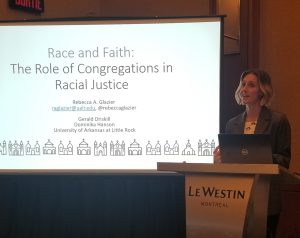This article was originally posted on the personal blog of Dr. Rebecca Glazier, the Director of the Little Rock Congregations Study. It is reposted here with permission: http://www.rebeccaglazier.net/the-line-between-research-and-advocacy/.

Rebecca Glazier presenting LRCS research on race and faith at the 2022 APSA Conference in Montreal, Canada.
Last week it was my privilege to present some recent work from the Little Rock Congregations Study at the American Political Science Association Conference, the largest annual conference for political scientists. It was wonderful to see friends and colleagues, hear about some great ongoing research and get some good feedback on my own work. But one question that I have been pondering ever since the conference is: what exactly is the line between research and advocacy? And where should my work fall?
The work that I presented was based on two years of research our team at the Little Rock Congregations Study has been doing on race and faith. We have conducted five major data collection efforts and learned some really interesting things:
- Among the diverse 35 congregations and nearly 2,300 members that we surveyed in 2020, race relations was the number one issue people most wanted their place of worship to get involved in helping to address.
- In the wake of George Floyd’s murder in the summer of 2020, our analysis of 90 sermons across 15 congregations showed that Black congregations were more likely to talk about race, say George Floyd’s name, and discuss the need for collective action, compared to white congregations.
- Interviews with 21 clergy from diverse congregations across Little Rock in 2021 demonstrated that many congregations engaged in formal programs to address race, from giving sermons to holding book groups. But when it came to discussing how race and faith were connected, both the qualitative and the quantitative data reveal a much deeper scriptural and spiritual connection for Black clergy.
Additionally, our research team dug deep into the literature on faith-based racial justice and reconciliation, interviewed seven national experts on the topic, created three models that congregations could choose from as starting points for engagement in racial justice and reconciliation, and held six focus groups for local congregations to provide feedback on those models. We created additional resources for congregations, got feedback from our Clergy Advisory Board, spent the summer meeting local clergy groups for additional input, and are planning to host a Race and Faith Summit to share all of these findings.
But that last paragraph…does it have any place in a peer-reviewed journal article? The Little Rock Congregations Study is a long-term community-based research project. One of our main goals is to return meaningful findings to the community we work with and have worked hard to build relationships with. That feels like an important part of our work, but some conference feedback indicated that parts of the paper felt too much like advocacy and not enough like research. Is there a place in academic scholarship to talk about the times when our research crosses the line into advocacy?
For academics who are interested, here is the version of the paper that I presented at the APSA conference: available through APSA preprints.
And for any Little Rock Religious Leaders who are interested, we just opened the registration site for the November 2 Race and Faith Summit: ualr.at/summit.
Yup, I just can’t seem to keep these two things separate.